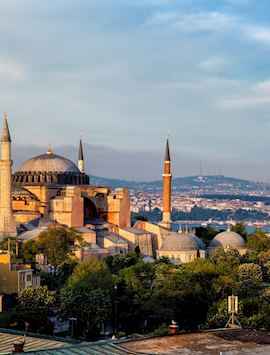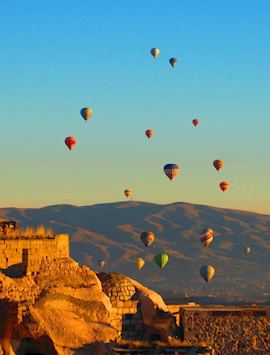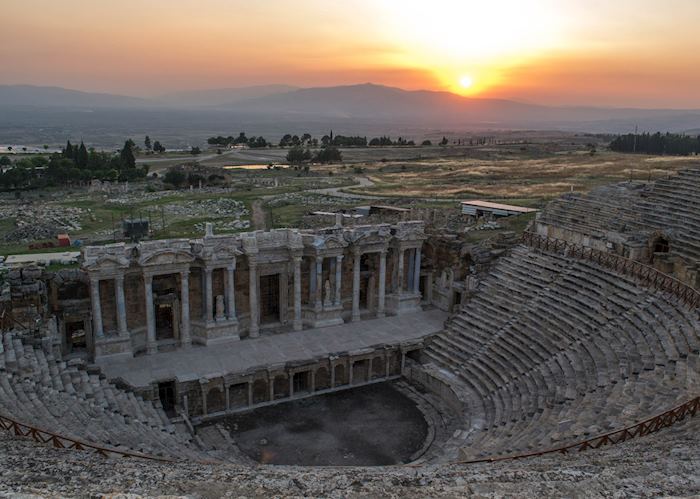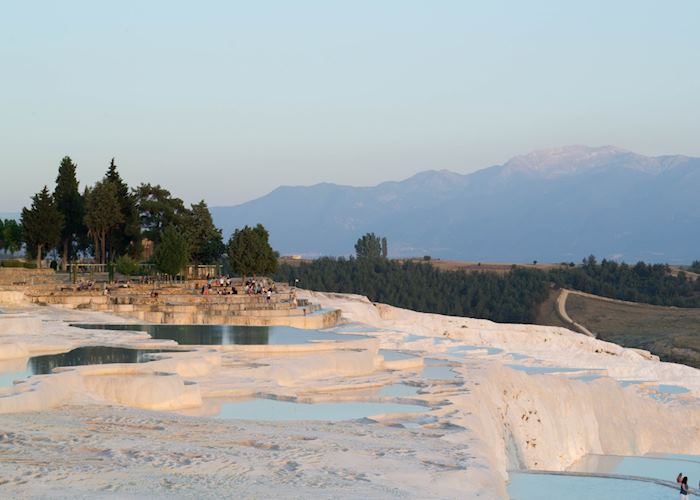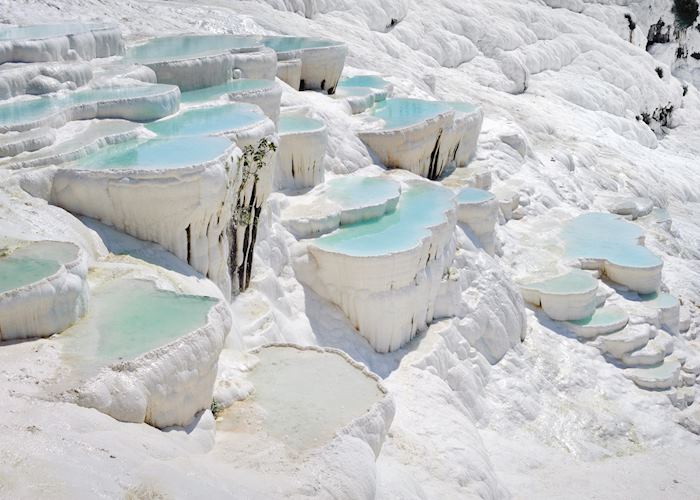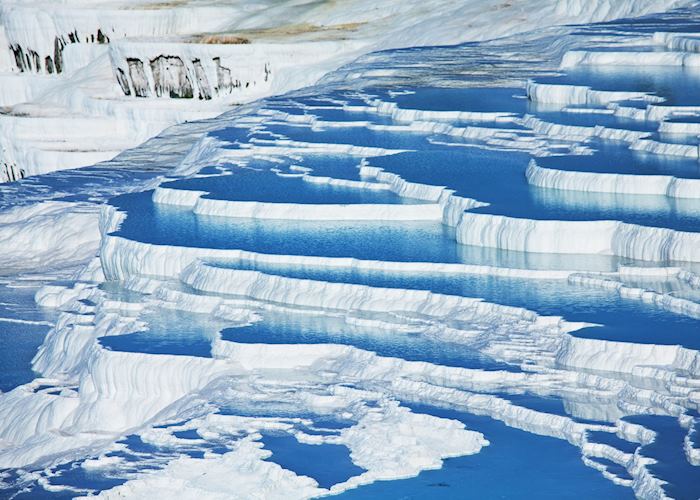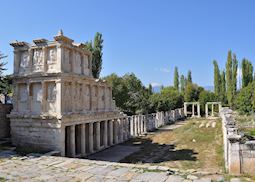Jump to:
Seen from afar, the white travertine terraces of Pamukkale look like some fantasy wonderland where, high above a valley, an icy landscape basks in the sun. This geological wonder was named Pamukkale, meaning ‘cotton castle’, by the local people and was formed when mineral waters from natural hot springs deposited brilliant white carbonite materials on the hillside creating a striking contrast to the clear blue skies above and lush valley below.
The ancient Greeks built a spa city here and its well-preserved remains sit above the present-day village in a landscape now protected as a UNESCO World Heritage Site.
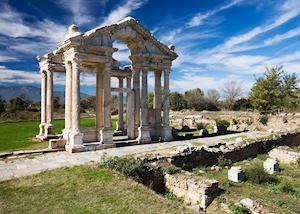 Pamukkale’s travertine terraces, with their semi-circular basins filled with milky, turquoise waters, cascade down the hillside above the modern village. Although the water from the 17 hot springs no longer runs through the terraces — it’s been diverted to allow the pools to recover from overuse — sections are artificially filled with water to show what the area once looked like. A designated path allows you to walk among the terraces without causing damage to the soft shelves of white rock, although you’ll have to remove your shoes and go barefoot.
Pamukkale’s travertine terraces, with their semi-circular basins filled with milky, turquoise waters, cascade down the hillside above the modern village. Although the water from the 17 hot springs no longer runs through the terraces — it’s been diverted to allow the pools to recover from overuse — sections are artificially filled with water to show what the area once looked like. A designated path allows you to walk among the terraces without causing damage to the soft shelves of white rock, although you’ll have to remove your shoes and go barefoot.
At the top of the ridge the Antique Pool leisure complex surrounds an artificial pool that, according to local legend, was sculpted from the rock as a gift from Marc Anthony to Cleopatra. A Roman temple once stood over it but was toppled by an earthquake in the 7th century, and as you swim in the bubble-filled mineral waters you can see the Doric columns lying below. The complex also has some restaurants and can get very busy in the afternoon when tour buses arrive, so come early for the best experience.
Beyond the pool on the upper ridge lies the ancient spa city of Hierapolis which was established around 190 BC and sits in a dramatic position above Pamukkale’s travertine terraces. The Greco-Roman city was important enough to have been visited by several emperors and was later used by the Byzantines. A series of devastating earthquakes led to it finally being abandoned in 1334.
Along with a 1st-century gymnasium, 2nd-century agora and late 4th-century Byzantine gate, you can see the well-preserved remains of a Roman theatre built to hold about 12,000 spectators. Among these sites are the ruins of the Temple of Apollo, a vast necropolis with circular tombs and, if you walk a little way from the main site, the Martyrium of St Philip the Apostle, an elaborate octagonal building set on the spot where St Philip was supposedly martyred. It’s a quiet place, well away from the crowds, that offers sweeping views over the surrounding landscape.
The Hierapolis Archaeology Museum is housed in the former Roman baths and displays finds from the site, including a Roman-era frieze, capitals from the agora and sarcophagi from nearby archaeological site Laodicea.
Most visitors to Pamukkale come on a day trip, however, if you stay overnight the town is quiet and even more impressive at sunset, and a longer visit allows you to see nearby archaeological sites such as Aphrodisias and Laodicea, Greek Hellenistic cities with substantial remains.
Best time to visit Pamukkale
Pamukkale is at its best between April and June, when the weather is dry and warm and the travertine terraces are not too busy. In July and August, the reflected light can make the brilliant white mountainside unbearably hot, and the crowds are at their peak. September and October are cooler and quieter but the chance of rain increases as winter approaches.
who's been there
-
01993 838 92501993 838 460
- Make an enquiry
Suggested itineraries featuring Pamukkale
Our itineraries will give you suggestions for what is possible when you travel in Pamukkale, and they showcase routes we know work particularly well. Treat them as inspiration, because your trip will be created uniquely by one of our specialists.
Photos of Pamukkale
Ideas for experiencing Pamukkale
Our specialists seek out authentic ways to get to know the places that could feature in your trip. These activities reflect some of the experiences they've most enjoyed while visiting Pamukkale, and which use the best local guides.
-
Aphrodisias and its ancient ruins tour ![Aphrodisias]()
Aphrodisias and its ancient ruins tour
Aphrodisias and its ancient ruins tour
Aphrodisias is a remarkable and vast site, which is mostly un-excavated. Its ruins are to be found amid the natural landscape, springing up from the greenery or half-buried in the dust.
View details -
Visit to Hierapolis and Pamukkale travertines ![Pamukkale travertines]()
Visit to Hierapolis and Pamukkale travertines
Visit to Hierapolis and Pamukkale travertines
This guided trip will take you to the limestone travertines of Pamukkale, which cascade down the hillside and to the ancient thermal spa town of Hierapolis.
View details



